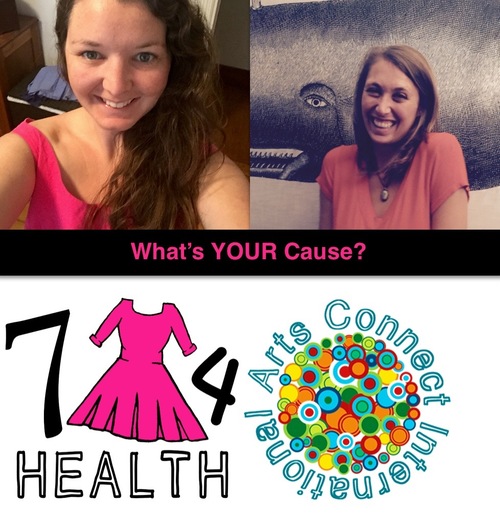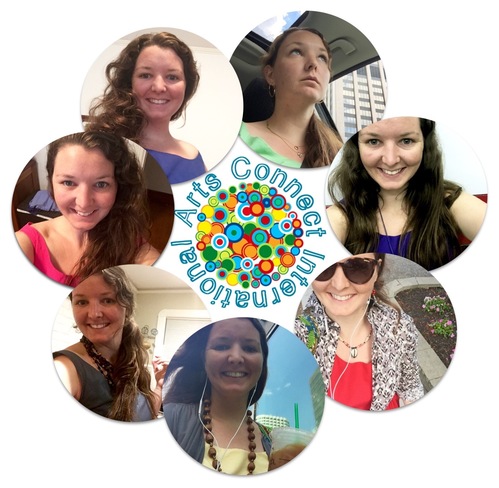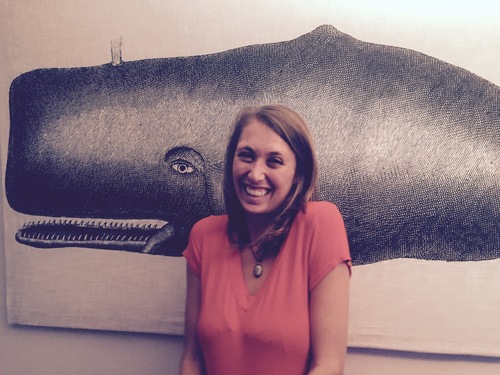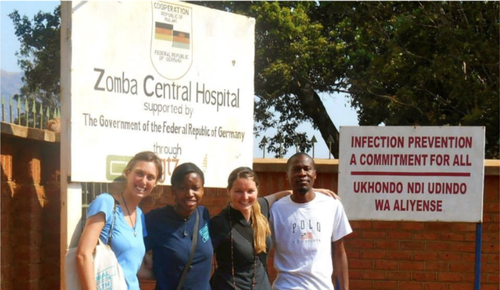7 DRESSES 4 HEALTH: Day 258 - Day 264 ~ September 16th - September 22nd ~
Guest Blogger Bio: This week's blog was written by Lindsey Kinsinger, a Global Health Corps fellow with Dignitas International in Zomba, Malawi from July 2013-2014. During her year, she had the opportunity to work with Dignitas staff to improve the current cervical cancer program at Zomba Central Hospital. Lindsey currently lives inDetroit, Michigan and works for the state health department. Her work focuses on STD and HIV surveillance, education and outreach for the city of Detroit.
Title: An Ounce of Prevention, an Ounce of Vinegar: Let’s Change the Dialogue on Sub-Saharan Cancer Care
Guest blogger: Lindsey Kinsinger
Cancer is, by many, considered a disease of the developed world. It is commonly left out of the dialogue (and therefore left out of the funding stream) for developing countries. There are many reasons people might justify this — cancer treatment is expensive. It takes large medical teams to administer care, chemotherapy is expensive, and radiation therapy requires a reliable source of
electricity that is often not practical when electrical grids are inconsistent...The list could go on and on. Not to mention, infectious diseases are prioritized — HIV, tuberculosis, malaria, diarrheal disease, etc. I am not saying these diseases are not important, but I also believe that we need to increase our understanding of cancer and its disease burden in the developing world...starting with cervical cancer.
Cervical cancer is a prime example of a cancer type that disproportionately affects developing nations, compared to developed nations. Out of the 274,000 deaths from cervical cancer in 2008, 241,000 (89%) were in low and middle-income countries
(1). Of the total 241,000 deaths, an estimated 85,000 (35%) occurred in sub-Saharan Africa
(1).This is significant, considering that sub-Saharan Africa’s population of 936 million only equates to 13.1% of the world population, yet it reports 35% of the world’s deaths from cervical cancer
There are several reasons why women in sub-Saharan Africa have an increased risk of dying from cervical cancer. First, many women are not being screened regularly for pre-cancerous lesions. In many developed nations it is recommended that women have regular pap smears with their gynecologist to check for early signs of cervical cancer. Second, sub-Saharan Africa has a
greater prevalence of HIV than many other regions of the world. This is important because HIV infection is correlated with a higher risk of chronic human papillomavirus (HPV) infection, and HPV infection is present in almost all women who develop cervical cancer (3). Moreover, untreated HIV infection accelerates the cancerous potential of HPV, blocking the immune system from
eliminating the virus (this is also why HPV vaccination significantly reduces a woman’s risk for cervical cancer... Get your children vaccinated!).
Many cancers are difficult to diagnose and treat - cervical cancer is not. Well, to be more specific, the early stages of cervical cancer are not. Before a women develops cervical cancer, pre-cancerous lesions form on the cervix — these are the lesions that result from the irregular cell growth that pap smears check for. Pap smears work well for countries that have strong healthcare
systems. However, they are resource-intensive for countries that have already strained healthcare systems, such as many countries in sub-Saharan Africa. In these settings, the World Health Organization (WHO) recommends visual screening of the cervix with acetic acid vinegar (VIA screening). VIA is a simple method to detect lesions, before they progress to cervical cancer. To put it extremely simply — The cervix gets a light coat of table vinegar (like the kind you put on fish n’ chips), and if lesions are present, the vinegar starts to bubble. It requires minimal resources (sitting surface, speculum, and acetic acid — AKA vinegar), and can be done with minimal training for health professionals (4).
If no lesions are discovered, women have no lasting effects from VIA screening, and can return to their daily activities immediately. If lesions are discovered, cryotherapy can be used to ablate the lesions, prior to progression to invasive cervical cancer. Cryotherapy uses liquid gas (commonly nitrogen) to freeze the lesions, and stop disease progression. It can take as little as 5-10 minutes to complete the procedure, and causes minimal discomfort or pain for the patient (4).
There are already many sub-Saharan countries that have successful cervical cancer screening and treatment programs. Of particular note is Zambia. Zambia’s former first lady, Dr. Christine Kaseba Sata, has been a prominent public advocate for cervical cancer awareness and has promoted an increase in screening among women in Zambia and sub-Saharan Africa (5). The collaboration between Zambia’s national government and several dedicated non-governmental organizations, such as Cervical Cancer Prevention Program in Zambia (CCPPZ) have helped Zambia become a leader in sub-Saharan Africa for cervical cancer screen and treat programs (5)(6).
So, since it is an overwhelming task to start treating all cancers in sub-Saharan Africa, why not start with cervical cancer? With increased awareness of the disease burden and increased funding, many other countries might be able to follow Zambia’s model and save countless lives with a simple, easy, and cheap fifteen-minute screening procedure.
So...
Let’s do it!
FYI
—
in Zomba, Malawi is currently raising awareness and funds to increase cervical cancer screening in the southeast region of Malawi (population ~3.1 million). Check them out at (1)
http://dignitasinternational.org/
. The author of this blog, Lindsey Kinsinger, did a Global Health Corps fellowship with Dignitas International from July 2013-July 2014. Check out the incredible work Global Health Corps is doing in Malawi, Zambia, Uganda, Rwanda, and the US at (2)
(1) The World Bank. (2013). Sub-Saharan Africa (developing only). Retrieved 10 10, 2014, from The World Bank: http://data.worldbank.org/region/sub-saharan-africa
(2) World Health Organization. (2012). GLOBOCAN 2012: Estimated Cancer Incidence, mortality and Prevelance Worldwide in 2012.
Retrieved 10 10, 2014, from World Health Organization: http://globocan.iarc.fr/Pages/fact_sheets_cancer.aspx
(3) Bosch FX, Burchell AN, Schiffman M, et al. Epidemiology and natural history of human papillomavirus infections and type-specific implications in cervical neoplasia. Vaccine. 2008; 26:K1-16.
(4) World Health Organization (WHO). (2013). Sexual and Reproductive Health. Retrieved 10 10, 2014, from World Health Organization: http://www.who.int/reproductivehealth/publications/cancers/screening_and_treatment_of_precancerous_lesions/en/
(5) Mwanahamuntu, M. e. (2013). Utilization of Cervical Cancer Screening Services and Trends in Screening Positivity Rates in a 'Screen-And-Treat' Program Integrated with HIV/AIDS Care in Zambia. PLOS ONE, 8(9), 7.6 http://www.cidrz.org/cervical-cancer/
Call to action: Do you have important information around one of our seven causes: HIV/AIDS, Mental Health, Nutrition, Heart Disease, Maternal Child Health, Cancer, Disability, that you want to share with a wider audience? Do you or a loved one currently live and/or struggle with one of these causes? Do you work in research, advocacy, prevention, treatment or care? We want to hear from YOU! Write to us today: 7dresses@artsconnectinternational.org to become a featured blog writer. Another way to get involved is to wear the color of the day in solidarity. Take a picture of yourself in the color of the day and Tweet it @ArtsConnectInt, tag us on Instagram @ArtsConnectInt, or send it to us on Facebook.
About 7 Dresses 4 Health (7D4H): 7D4H is a year-long arts and health education campaign lead by visual artist, Marian Brown, in conjunction with Arts Connect International. The objective of the campaign is to promote inclusive community practices through adDRESSing health artistically and collaboratively. To learn more about the genesis of the project, read Marian’s New Year Blog.
About this week's look & location: All of the dresses for 7 Dresses 4 Health were designed and sewn by Kim's Fashion Design. Love the look? Visit Kim at 100 Huntington Ave, Boston MA 02116, call her at (617) 267-9299 or email her: info@kimsfashion.com. Mention 7 Dresses 4 Health for a special discount!
Campaign Update (2017): All 7 Dresses 4 Health blogs were migrated from a former site, so the sharing analytics are inconsistent from when they were first published. We apologize to our guest bloggers, and readers, for this inconvenience. That said, the campaign garnered an average of 5K hits per blog, over 500,000 readers throughout 2015! Additionally, the average number of shares per guest blog was over 150x on social media (through Facebook and Twitter). Thank you for making this incredible campaign possible - and for all that it was for so many. With gratitude, Marian & the ACI Team





